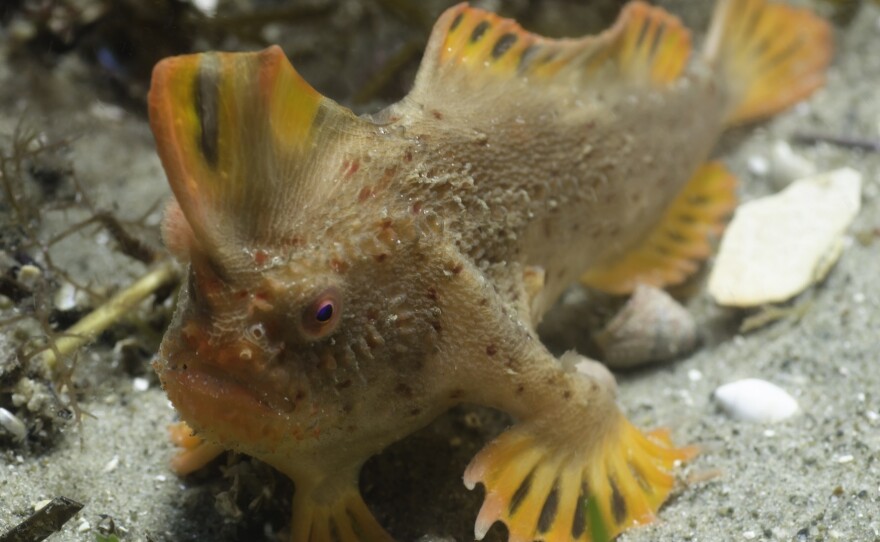The known population of one of the world's rarest fish has just doubled, thanks to a lucky find in the waters off Tasmania, Australia.
Meet the red handfish, a name that reflects the hand-shaped fins on the sides of its body. The striking creature doesn't really swim — it "walks" slowly along the seafloor. And until recently, researchers say they were aware of only one colony of the rare animals, with around 20 to 40 fish.
A team of seven divers from Australia's Institute for Marine and Antarctic Studies and the Reef Life Survey heard reports that a red handfish was seen in another area and went down to investigate.
After two days of fruitless searching, they were about to call the mission off when IMAS technical officer Antonia Cooper spied a red bottom-dweller.
"I was halfheartedly flicking algae around and, lo and behold, found a red handfish," she says in an IMAS video. "Once we found that first one, I signaled to the other divers that we had a sighting, which meant we could then focus our search area to that same spot. And sure enough, in a 50-meter-by-20-meter area, we discovered another eight fish."
The scientists think that the new colony has another 20 to 40 fish. And it's "a number of kilometers away" from the other known group. Because handfish move so slowly, that suggests that they are genetically distinct.
"It means there's potentially a bigger gene pool and also that there are potentially other populations out there that we're yet to find, so it's very exciting indeed," Cooper said.
The species has recently gone through a "marked decline," according to the Australian government. It is believed to rely on green algae as a place to spawn, and that environment is being degraded because of an increase in a sea urchin population that grazes on the algae. Rising water temperatures are also threatening this species and many others.
National Geographic details other factors impacting the fish:
"They lay their eggs at the base of pieces of seaweed, so it's easy for those eggs to get jostled or knocked off by swimmers and boats. They're also threatened by poaching to be used as pets, and their low reproductive and dispersal rates don't help their dwindling numbers either."
The new population, however, is providing useful information to scientists that could help with recovery efforts.
"We've already learned a lot from finding this second population because their habitat isn't identical to that of the first population, so we can take some heart from knowing Red Handfish are not as critically dependent on that particular set of local conditions," IMAS scientist Rick Stuart-Smith said in a statement.
The scientists are keeping quiet about the location of the newly discovered population until they can determine ways to properly manage the area.
This isn't the only type of handfish. Another member of the family, the spotted handfish, is still seen in waters near Tasmania's city of Hobart.
But according to IMAS, a third type, called Ziebell's handfish, may be gone forever. "Ziebell's handfish hasn't been seen in over a decade, and there is a feeling that it's quite possibly extinct, or at least very close to being so," Stuart-Smith said.
He added: "The only thing that would have been more exciting last week would have been finding the Ziebell's and finding out that they're not extinct."
Copyright 2018 NPR. To see more, visit http://www.npr.org/.






